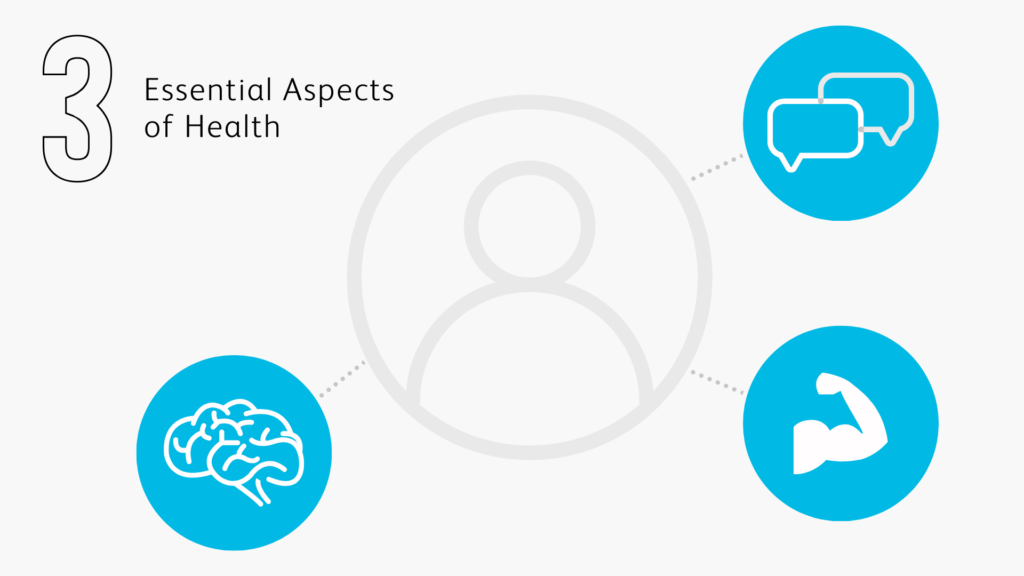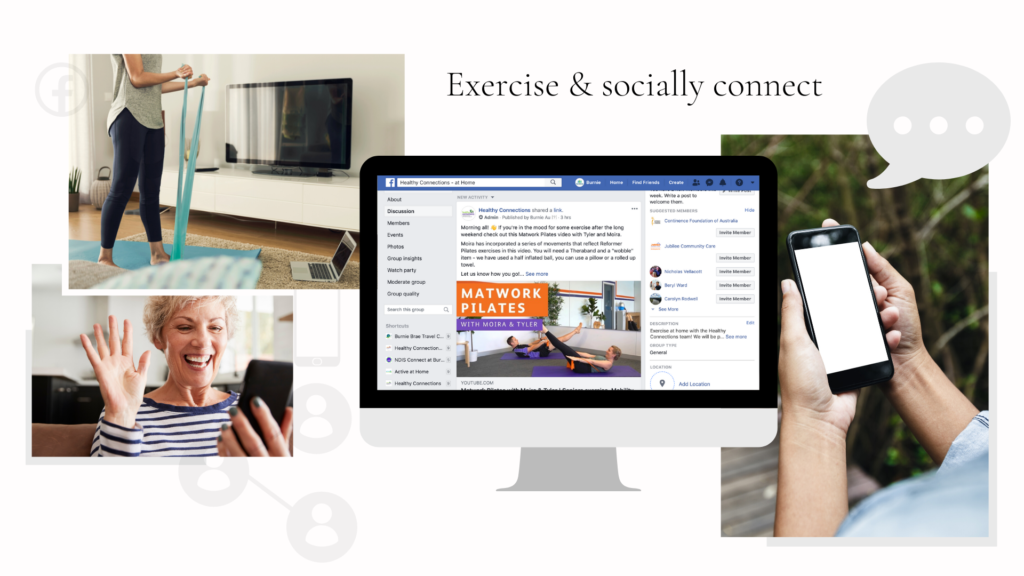
Sophie Pacek
Exercise Physiologist, Healthy Connections
Self-isolation is hard. I find it difficult because I am by nature a sociable person. In normal times, I like going out to see loved ones – to eat at cafes, to see movies together at the cinema, and to exercise at the gym with my friends. I do not live alone but I do feel distanced from friends and family that I do not live with. However, I believe that ‘physical’ distancing does not mean we need to ‘socially’ distance ourselves. Humans are meant to interact with each other (more on this below), so I came up with a grand plan on how to keep socially and physically active with my mates to maintain everyone’s sanity.
Why is staying socially connected important?
Humans are social creatures – we are drawn to share knowledge and understanding of the world through verbal and nonverbal communication with each other. Researchers believe this can be explained by nerve cells in our brain called mirror neurons (Hari & Kujala, 2009). As their name suggests, these cells allow us to ‘mirror’ or match to each other’s messages and emotions.
For example, we can tell by someone’s facial expressions and the tone and pitch of their voice when they are happy or sad and we respond with the appropriate messages of happiness or sympathy (watch this video for more information on mirror neurons). We also seek approval, commonality and a sense of belonging with other people because it makes us feel wanted and happy. Fulfilling these desires becomes difficult when we are physically isolated.
Since the coronavirus outbreak, news headlines have stated the significant influx of calls to mental health support services like BeyondBlue and Lifeline. Historical data shows that approximately 25-33% of individuals experience high levels of anxiety and worry during similar pandemics due to a range of reasons, including the experience of self-isolation or quarantine (Black Dog Institute, 2020). The potential deleterious effects of quarantine include fear of infection, depression, confusion, frustration, boredom and loneliness (Black Dog Institute, 2020). Therefore, it is not surprising that people are reaching out for some interaction and comfort in these uncertain times.
(Note: if you are experiencing any of the above emotions, visit the Australian Government’s Head to Health page on COVID-19 support here. There are also many free support services available – details are at the end of this blog.)
What has exercise got to do with this?
Exercise is a beautiful thing. Why? Because it combines three essential aspects of health (what I like to call the trinity of health): physical, mental and social stimulation. Physically, it improves cardiovascular fitness, lung function, muscular and bone strength and can assist with maintaining a healthy weight and reduce the risk of many chronic conditions (Reiner, Niermann, Jekauc & Woll, 2013). Mentally, it releases endorphins and improves your mood (for more information on the mental benefits of exercise, please see our previous blog). Of equal importance is that exercise provides a domain or opportunity to interact with others. And yes you might be thinking, ‘I can socialise by going out for a coffee or calling a friend and that’s a lot less physical work’, but these activities do not fulfil the trinity of health quite like exercise does.

How can we exercise and be sociable at the same time in different places?
So this is where my grand plan evolved – how could I stay socially connected with my friends whilst getting us moving in the comfort of our respective homes? Virtual workouts of course! I used a combination of the below methods to enjoy a hard but rewarding exercise session with my pals.
There are lots of ways to stay socially connected in self-isolation, and we would encourage you to do so not only with your loved ones but also with the people you exercise with at Healthy Connections.
- Phone calls – an oldie but a goodie; everyone has a phone these days. If you are talking to a friend on the phone, try to stand up and walk around your home, or go outside for a walk while you chat.
- Video calls – if you have access to a smartphone, tablet or computer, you can video call via platforms like Skype, FaceTime, Facebook Messenger, Whatsapp, Zoom and the list goes on. If you’re like me and are technologically challenged, ask a grandchild or friend to help you set things up.
- Social media (Facebook / Instagram) – it is true that there can be a lot of rubbish on social media, but it is an effective way to stay connected with the world and loved ones who live elsewhere. It is also a great way of getting in touch with someone if you do not have their phone number. If you’re worried about privacy, you can set your profile only to show information to people you are ‘friends’ with (get that grandchild or friend to help you out with this too). It is also one of the platforms we use to give you the latest tips and tricks on how to exercise at home. Why not call up your exercise buddy and do a workout from the Healthy Connections Facebook page together?
- Text messages – a great way to stay in touch with someone who does not have the time to have a 30-minute conversation or do a 45-minute workout with you, or who is in a different time zone. Message exercise reminders to your friends to keep them accountable, or set up a weekly challenge for all of you to complete (e.g. track the number of daily steps and message the amount to your friends at the end of each day, then tally up at the end of the week to see who achieved their goal).

How did my grand plan go?
After a few technological hiccups, our virtual video call workouts are a success! We performed our sixth exercise session together last weekend, which is more often than what we did together pre-COVID-19. Each week we take turns picking / creating an exercise plan to perform, and I find that I work harder and feel more motivated to exercise when doing it with someone. We also have a good laugh and chat at the end. In these workouts, I forget about the current global situation and focus entirely on the moment.
I challenge you to utilise available technology and reach out to an exercise peer or friend. I promise you, you will both feel better for it.
Please share your virtual workouts in the comments below, on our Facebook page or let us know at the clinic on 3624 2185.
As always, stay safe, wash your hands and keep moving!
Sophie
Please find below free support services if you are feeling down or want to chat with someone.
BeyondBlue – 1800 512 348
Lifeline – 13 11 14
MensLine Australia – 1300 78 99 78
As university-trained exercise physiologists, we use evidence from high-quality research studies to support our recommendations so many of these blogs will refer to research journal articles. If you would like to know more about this topic and the studies cited in the blog, please refer the the references below.
References
- Black Dog Institute. (2020). Mental Health Ramifications of COVID-19: The Australian context. Retrieved from https://blackdoginstitute.org.au/docs/default-source/default-document-library/20200319_covid19-evidence-and-reccomendations.pdf
- Hari, R., & Kujala, M. V. (2009). Brain Basis of Human Social Interaction: From Concepts to Brain Imaging. Physiological Reviews, 89(2), 453-479. https://doi.org/10.1152/physrev.00041.2007
- Reiner, M., Niermann, C., Jekauc, D., & Woll, A. (2013). Long-term health benefits of physical activity – a systematic review of longitudinal studies. BMC Public Health, 13(813), 1-9. Retrieved from https://bmcpublichealth.biomedcentral.com/articles/10.1186/1471-2458-13-813



